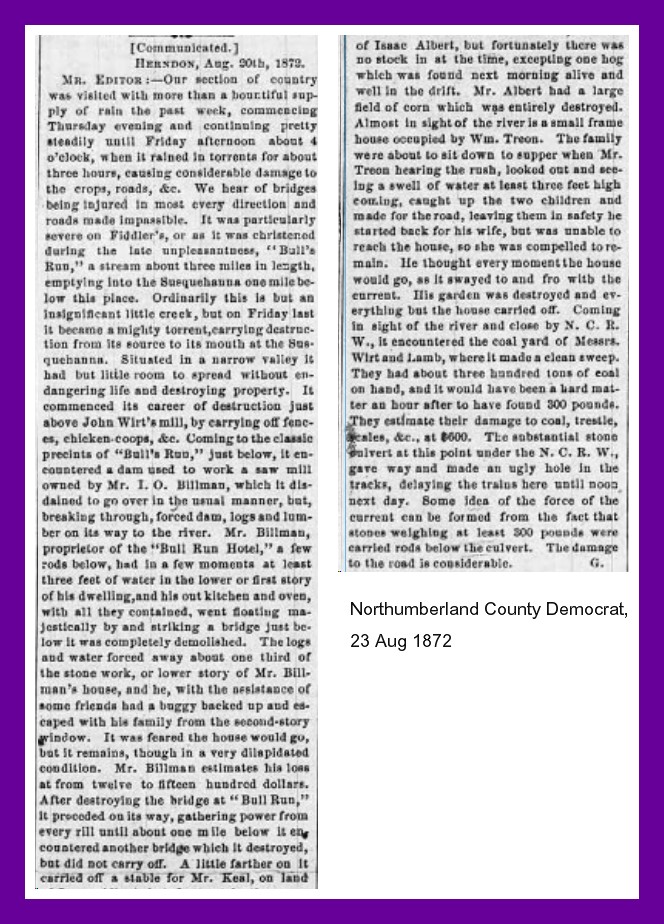From the pages of the Northumberland County Democrat, Sunbury, August 23, 1872, comes this story of the damage caused by serious flooding in the area of Fiddler’s Run, Herndon, Northumberland County, Pennsylvania. Fiddler’s was given the nickname “Bull Run” by local residents who had participated in the Civil War.
Herndon, Aug. 20th, 1872.
Mr. Editor: — Our section of country was visited with more than a bountiful supply of rain the past week, commencing Thursday evening and continuing pretty steadily until Friday afternoon about 4 o’clock, when It rained in torrents for about three hours, causing considerable damage to the crops, roads, etc. We hear of bridges being injured in most every direction and roads made impassable. It was particularly severe on Fiddler’s, or as it was christened during the late unpleasantness, “Bull’s Run,” a stream about three miles In length, emptying Into the Susquehanna one mile below this place. Ordinarily this is but an insignificant little creek, but on Friday last it became a mighty torrent, carrying destruction from its source to its mouth at the Susquehanna. Situated in a narrow valley It had but little room to spread without endangering life and destroying property. It commenced its career of destruction just above John Wirt‘s mill, by carrying off fences, chicken-coops, etc. Coming to the classic precincts of “Bull’s Run,” just below, it encountered a dam used to work a sawmill owned by Mr. I. O. Billman, which it disdained to go over in the usual manner, but, breaking through, forced dam, logs and lumber on its way to the river. Mr. Billman, proprietor of the “Bull Run Hotel,” a few rods below, had in a few moments at least three feet of water in the lower or first story of his dwelling and his out kitchen and oven, with all they contained, went floating majestically by and striking a bridge just be low it was completely demolished. The logs and water forced away about one third of the stone work, or lower story of Mr. Billman’s house, and he, with the assistance of some friends, had a buggy backed up and escaped with his family from the second-story window. It was feared the house would go, but it remains, though in a very dilapidated condition. Mr. Billman estimates his loss at from twelve to fifteen hundred dollars. After destroying the bridge at “Bull Run,” it proceeds on its way, gathering power from every rill until about one mile below it encountered another bridge which it destroyed, but did not carry off. A little farther on it carried off a stable for Mr. Keal, on land of Isaac Albert, but fortunately there was no stock in at the time, excepting one hog which was found next morning alive and well in the drift. Mr. Albert had a large field of corn which was entirely destroyed. Almost in sight of the river is a small frame house occupied by William Treon. The family were about to sit down to supper when Mr. Treon hearing the rush, looked out and seeing a swell of water at least three feet high coming, caught up the two children and made for the road, leaving them in safety he started back for his wife, but was unable to reach the house, so she was compelled to remain: He thought every moment the house would go, as it swayed to and fro with the current. His garden was destroyed and everything but the house carried off. Coming In sight of the river and close by N. C. R. W. [Northern Central Railway] It encountered the coal yard of Messrs, Wirt and Lamb, where It made a clean sweep. They had about three hundred tons of coal on hand, and it would have been a hard matter an hour after to have found 300 pounds. They estimate their damage to coal, trestle, and scales, etc., at $600. The substantial stone culvert at this point under the N. C. R. W., gave way and made an ugly hole in the tracks, delaying the trains here until noon, next day. Some idea of the force of the current can be formed from the fact that stones weighing at least 300 pounds were carried rods below the culvert. The damage to the road is considerable. G.
_________________________________________
Submitted/transcribed by David Hause. Image from Newspapers.com.
Corrections and additional information should be added as comments to this post.
